




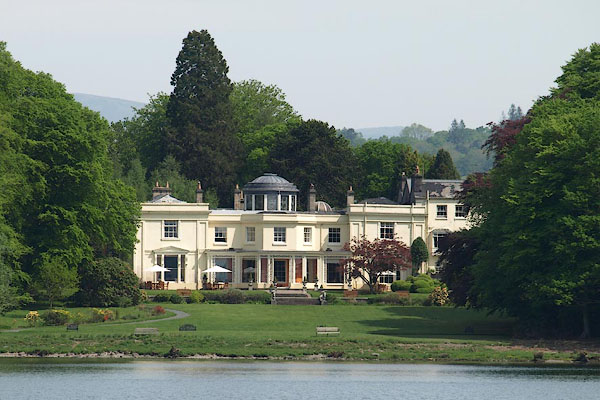
BPD41.jpg (taken 12.5.2008)
placename:- Storrs Hall
placename:- Stores
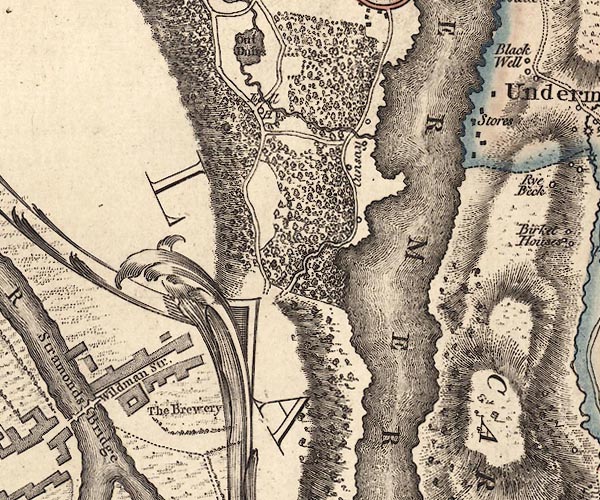
J5SD39SE.jpg
"Stores"
blocks, labelled in italic lowercase text; settlement, village?
item:- National Library of Scotland : EME.s.47
Image © National Library of Scotland
 goto source
goto sourcePage 71, footnote:- "On the banks of Windermere-water, have been lately built many elegant villas; by ... John Bolton, Esq. Storrs; ... These objects, as works of art, most of which are done in styles suitable to their situation, give an air of consequence to the country, ..."
placename:- Storrs Hall
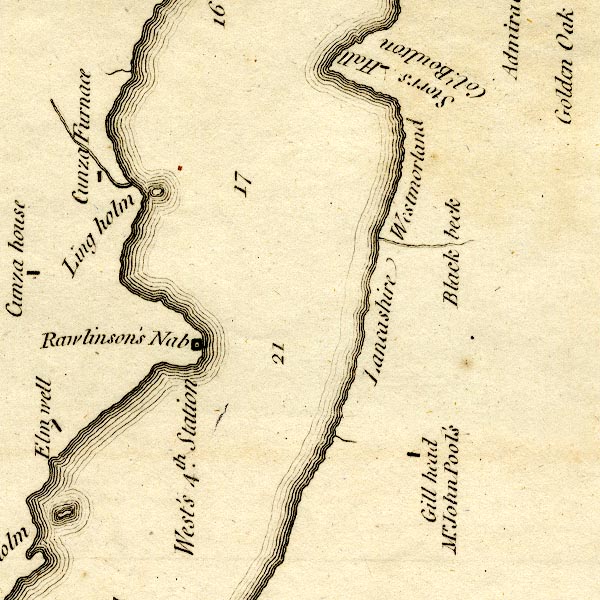
CT9SD39W.jpg
"Storrs Hall / Coll. Boulton"
block, building/s
item:- Armitt Library : 2008.14.102
Image © see bottom of page
placename:- Stors

Ws02SD39.jpg
item:- Armitt Library : A1221.1
Image © see bottom of page
placename:- Storcs
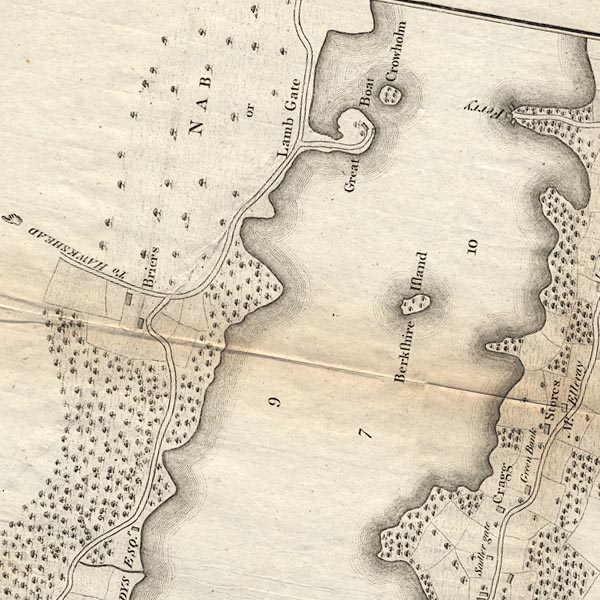
CLBSD39X.jpg
"Storcs / Mr. Elleray"
item:- private collection : 10.11
Image © see bottom of page
placename:- Stores
 goto source
goto source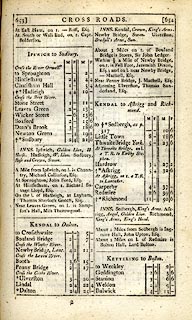 click to enlarge
click to enlargeC38653.jpg
page 653-654 "About 3 Miles on r. of Bouland Bridge is Stores, Sir John Ledger."
item:- JandMN : 228.2
Image © see bottom of page
placename:- Storrs
 goto source
goto sourcepage 8:- "... Storrs, the beautiful seat of John Bolton, Esq. ..."
placename:- Stors

OT02SD39.jpg
item:- JandMN : 48.1
Image © see bottom of page
placename:- Storrs Hall
 goto source
goto sourcePage 4:- "... Storrs-Hall, the mansion of Colonel Bolton, is beautifully situated upon a low promontory, ..."
placename:- Storrs Hall
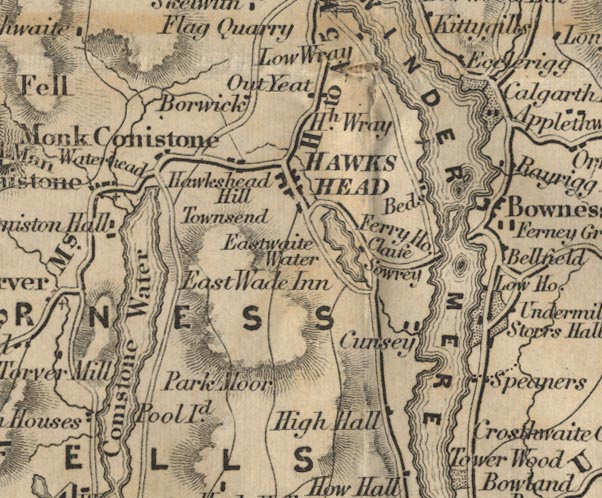
FD02SD39.jpg
"Storrs Hall"
Building and park.
item:- JandMN : 100.1
Image © see bottom of page
placename:- Storrs Hall

GAR2SD39.jpg
"Storrs Hall"
block, building
item:- JandMN : 82.1
Image © see bottom of page
placename:- Storr's Hall
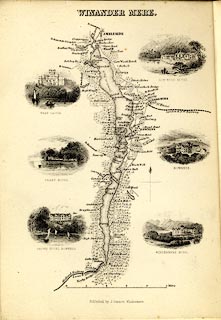 click to enlarge
click to enlargePI03M1.jpg
"Storr's Hall"
block/s; building/s
item:- private collection : 133.1
Image © see bottom of page
placename:- Storrs Hall
 click to enlarge
click to enlargeBEM107.jpg
On p.38 of a Handy Guide to the English Lakes and Shap Spa.
printed at bottom:- "STORRS HALL."
item:- JandMN : 455.9
Image © see bottom of page
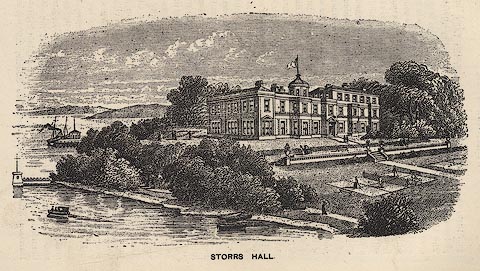 click to enlarge
click to enlargePW1E14.jpg
"STORRS HALL."
item:- JandMN : 58.15
Image © see bottom of page
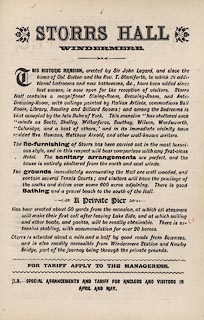 click to enlarge
click to enlargePW1A03.jpg
Guide book published by George Philip and Son, 32 Fleet Street, London, Philip, Son and Nephew, Liverpool, Lancashire, and Titus Wilson, Kendal, Westmorland, about 1895.
item:- JandMN : 58
Image © see bottom of page
placename:- Storrs Hall
courtesy of English Heritage
"STORRS HALL / / NEWBY BRIDGE ROAD / WINDERMERE TOWN / SOUTH LAKELAND / CUMBRIA / II[star] / 351696 / SD3926294134"
courtesy of English Heritage
"Simple classical villa, mid 1790s, for Sir John Legard, transformed c1808-9 by Joseph Gandy for John Bolton. The clerk of works was Francis Webster. Converted to a hotel c1892 by Joseph Pattinson, who heightened the service wing to a uniform three storeys."
"EXTERIOR: The central building and wings are faced with sandstone ashlar, the facing having been applied to the central building for John Bolton. The stone for the work of 1808-9 is said to have come from the quarry on the Holker estate, 15 miles from Storrs. Now stuccoed. The service wing is of rendered rubble. The main house is two storeys, the original mid-1790s house forming the central portion - square, three bays wide, with canted central bay to south elevation - whilst the work of c1808-9 added wings to east and west, slightly taller than the original house, and projecting to north and south. The wings are one bay wide and three bays deep; a service wing is built on to the east end of the east wing. The corners of the bays have shallow angle pilasters with sunk faces, the bays of the wings separated by identical pilasters. Above, a plain entablature supports a blind parapet. The north and south elevations of the wings have tripartite ground-floor windows with thick scrolled console brackets supporting triangular pediments; the first-floor windows have moulded surrounds, their sides terminating in moulded block capitals. Identical first-floor windows on the west elevation of the west wing; on the ground floor, the central window is tripartite with pediment but without brackets, the outer windows have scrolled brackets supporting flat hoods with lotus bud cresting. Sash windows; a number of those in the west wing retain their original frames with brass glazing bars. On the north elevation, the projecting wings are linked by an entrance loggia of c1808-9. A Greek Doric colonnade between screen walls with niches; originally empty, these contain pedestals and lamps. The columns are of the Samian type, the upper parts of the columns and pilasters being fluted. The entablature supports a parapet of fleshy lotus buds. The doorway, remodelled by Gandy, has a central opening with overlight flanked by narrow windows, the whole crowned by four console brackets supporting an entablature decorated with stylised rosettes. On the south elevation, the wings are linked by a verandah, also c1808-9, with canted bay following that of the original house. This has been substantially altered, and is now glazed. The lotus-bud parapet has been lost, but Gandy's geometric openwork wooden panels framing the bays survive. The eastern service wing, originally in three parts, of differing heights, was raised to a uniform three storeys c1892; moulded bands survive, indicating the heights of the original walls. The central range contains a courtyard. An original tripartite ground-floor window remains in the south wall of the easternmost range, and at the centre of the east elevation of this wall is the original round-headed entrance to the courtyard."
"INTERIOR: On the north side is the entrance hall, with a segmental-arched opening leading into the central rotunda. This circular hall, created by Gandy, has a balustraded first floor gallery, surmounted by a domed lantern rising from an entablature with a scalloped, fluted frieze, the dome having moulded ribs and a central roundel incorporating a flower burst. The glass is light blue, orange, and yellow. To the west is the stair hall, where Gandy inserted a new cantilevered staircase with decorative brass balustrade lit by an oval dome, and replaced a wall with a screen comprising an Ionic column and pilasters; at first-floor level the detailing is Composite. To the south is a large room with the original late C18 enriched cornice, opening on to the canted bay overlooking the lake. In the west wing, at ground-floor level, are two rooms, not originally interconnected as they now are. The southern room has a pair of doorways flanking the fireplace. The doors - mahogany, with ebony beading and strips of brass inlay - are unusual in having two panels above one wider panel. The marble chimneypiece has female figures to either side, and a panel depicting Leda and the Swan in the centre. A luxuriant cornice, featuring acanthus leaves and scrolls, runs around the main part of the room; the ceilings of the northern and southern bays are slightly lower. C20 panels and roundels now decorate the walls, which were originally plain. In the larger room on the ground floor of the east wing, originally the dining room, Gandy's idiosyncratic flair is strongly in evidence. The room has four doorcases, each with moulded architrave surmounted by frieze and cornice, the frieze with a running vine scroll incorporating alternating vine leaves and bunches of grapes. There are two original mahogany doors each with six beaded panels. The black marble chimneypiece has diagonally-set fluted columns and a central gilt brass winged head. To the south of this room is a passage providing access to the house from the service wing. Most of the first-floor rooms retain cornices of the late C18 and early C19, and panelled window reveals, but no chimneypieces survive. The basement contained the service rooms when the house was first built, with cellars along the north and east sides. The whole was used as cellars after Gandy built the new service wing, the original eastern subterranean access tunnel being extended under the service wing. The rooms and cellars, which have segmental stone vaults, have received little structural alteration."
"To the north of the house is a boathouse, probably built in the mid 1790s, at the same time as the original house. To the west of the house, at the end of a causeway into the lake, is a temple, now known as Storrs Temple (q.v.), built by Sir John Legard to honour four naval heroes, probably not long after 1797. Considerably further NNE, and no longer within the Storrs Hall grounds is a lodge, designed by Gandy c1806."
"HISTORY: Storrs Hall was built by Sir John Legard, sixth baronet of Ganton in Yorkshire (c1758-1808). An officer in the Royal Horse Guards, and a man of letters, Sir John frequently visited the continent with his wife, living for a time in Switzerland. The time they spent at a villa near Lake Geneva in 1791 may have inspired the wish to live in the Lake District; Sir John was a keen sailor. In the early 1790s he bought the land on Lake Windermere, where numerous villas were built during the second half of the eighteenth century, as the popularity of the Lake District grew. Storrs Hall was finished by 1797. The house and its owner were noted features of the area, commented on by several visitors; William Wilberforce called on Sir John in 1795, when the house may have been under construction, but found him not at home. Legard built a boathouse early in his occupation, and in 1804 an undated design for another, much more ambitious boathouse, was exhibited at the Royal Academy by Joseph Gandy, who was soon to remodel Storrs Hall for another owner. Sir John also built a little temple celebrating British naval triumphs of the mid 1790s. He enjoyed sailing, and racing, his own boat, 'Victory', and when crippled by gout in later life, he was carried on board."
"In 1804 Legard sold the house to David Pike Watts, a London wine merchant and uncle of the painter John Constable, who had recently inherited a fortune from his employer. His almoner, Mr Worgan, who lived in a cottage at Storrs, entertained members of the local literary and artistic circle, who at least once breakfasted in the temple. Constable stayed with Mr Worgan during a visit to the Lake District in 1806. But Pike himself does not appear to have spent much time at Storrs, and in 1806 he settled in London. He made no significant alterations to Storrs Hall."
"The next owner of Storrs was John Bolton (1756-1837). Bolton was born in Ulverston, the son of an apothecary, and was educated at the Town Bank Grammar School. He was then apprenticed to the firm of Rawlinson & Chorley, West India merchants and shipowners; after two or three years, aged about 17, he was sent to St Vincent. An acquaintance recalled seeing him shortly after his arrival, dressed in a sailor's jacket and trousers and carrying a bag of potatoes and a cheese - goods which formed his own private property to be sold for cash. From these beginnings, whilst continuing to work for Rawlinson &Chorley, Bolton built up enough money to return to Liverpool in 1786 and start in business on his own account. He rapidly became the leading West India merchant of his generation, with interests in Jamaica and St Vincent; his annual profits were rarely below L38,000. Bolton's trade was principally in slaves, and the goods they produced - sugar, rum, and cotton. He was the owner of several ships, including the 'John', and the 'King George', which sailed for Angola in 1799, fitted to carry 402 and 550 slaves, respectively. Bolton took a leading role in the social and political affairs of Liverpool. He was president of the Liverpool Association of West India Merchants; and when in 1797 the security of Liverpool was in question, following the failed French invasion of Wales, Bolton was one of those charged with overseeing the defence of the town. In 1803 he raised and financed a regiment of volunteers which became known as 'Bolton's Invincibles'; this was disbanded in 1806, but Bolton remained 'Colonel Bolton' for the rest of his life. A staunch tory, Bolton's house in Duke Street was the Liverpool headquarters of the party; his friends George Canning and William Huskisson frequently delivered speeches from the balcony. Like many other prosperous Liverpool merchants, Bolton chose to spend part of his time at a country house, whilst remaining active in the life of the town, and in 1804 he bought Bolton Hall in Lancashire (probably for its name). Although Gandy started work there, making alterations in the Gothic style, he was soon diverted by Bolton's purchase of Storrs Hall. Before long, Bolton and his wife Elizabeth Littledale, daughter of a merchant of Whitehaven and Liverpool, were spending much of their time in the Lake District, where they had their house decorated and furnished with exceptional lavishness. One reminder of the source of this opulence lay in the handsome and unusual mahogany doors which graced the public rooms. The importation of mahogany depended on the slave trade; the wood was brought back from the West Indies in ships which had deposited their human cargoes at West Indian plantations. Bolton was involved in some acrimonious episodes as a man of business - in 1809 one associate published a book attempting to discredit him (Bolton burned all available copies but one) and in 1805 the Colonel killed a Major Brooks in the last duel fought in Liverpool, apparently caused by a dispute over pay - Brooks was judged the aggressor, and no action was taken. At his lakeside villa, on the other hand, Bolton enjoyed a sparkling social life, accepted by the cultivated society of the region. One of his closest local friends was Professor John Wilson, better known as Christopher North of 'Blackwood's Magazine'. William Wordsworth, a companion in Bolton's later years, spoke of him as his 'long loved, tried and sincere friend.' Bolton was an enthusiastic sailor, taking part in regattas on the lake. On a particularly triumphant occasion, in August 1825, Bolton entertained Canning, Sir Walter Scott, Wordsworth, Robert Southey and others, installing them on his cedar barge for 'one of the most splendid regattas that ever enlivened Windermere.' Scott's son-in-law commented that 'It has not, I suppose, often happened to a plain English merchant, wholly the architect of his own fortunes, to entertain at one time a party embracing so many illustrious names.' Bolton, referred to by Wordsworth as 'the Liverpool Croesus', also took on the role of local philanthropist, paying for the Bowness Grammar School, which was still incomplete at his death in 1837. A local historian commented in 1847 that, 'The latter part of his life was spent in doing good.' His body was carried ceremoniously from Liverpool, to be buried at St Martin's church, Bowness, where an inscribed stone marked his vault (the stone has since been moved). Following Bolton's death, his wife remained at Storrs, where in 1840 she received Queen Adelaide, the Queen Dowager, who was visiting the area."
"When Elizabeth Bolton died in 1848, the house, and fortune, were left to her nephew, the Reverend Thomas Staniforth. Staniforth, after retiring from his Lancashire parish in 1859, moved, with his wife, to Storrs, where he lived the life of a country gentleman. He did not alter the house. Staniforth died without heirs in 1887, and in 1889 the estate was sold in lots; in 1892 the house opened as the Storrs Hall Hotel. The building has remained a hotel, under a succession of owners. Storrs Hall was re- opened after extensive renovation in 1998 by its current owner, a Lancashire businessman."
"SOURCES:"
"I. Goodall, 'Storrs Hall, Windermere', The Georgian Group Journal, XV, (2006) 159-"
"I. Goodall, 'Storrs Hall, Windermere, Cumbria' (report for English Heritage, 2002)"
"N. Pevsner, 'Buildings of England. Cumberland and Westmorland' (1967), 229"
"W. Sayer, 'History of Westmorland', 2 vols(1847), I, 252-62"
"A. Taylor, 'The Websters of Kendal, A North-Western Architectural Dynasty' (2004)"
"C. Jones, 'John Bolton of Storrs 1756-1837' (1959)"
"G.W. Mathews, 'John Bolton, A Liverpool Merchant, 1756-1837', Transactions of the Historic Society of Lancashire and Cheshire, XCIII (1941), 98-115"
"D. Thomason, 'New Light on John Bolton of Storrs', Abbot Hall Quarto, XXIV.1, (April 1986), 4-9"
"Information sheet produced by English Lakes Hotels [2007]"
"REASONS FOR DESIGNATION Storrs Hall is designated at Grade II[star] for the following principal reasons: [bullet] Striking lakeside villa of bold and original design. Largely the creation of architect Joseph Gandy, one of a small number of his surviving buildings; exotic both internally and externally, the house displays his idiosyncratic treatment of classical forms [bullet] Internal decoration and fittings of the highest quality, including inventive and luxuriant plasterwork and chimneypieces [bullet] Strong connection with John Bolton, slave trader and West India merchant, adds to historical interest of building."
"This list entry has been amended as part of the Bicentenary commemorations of the 1807 Abolition Act."
placename:- Storr's Hall
item:- moonlight
 click to enlarge
click to enlargeSYL122.jpg
On p.69 of Sylvan's Pictorial Guide to the English Lakes.
printed at bottom:- "STORR'S HALL."
item:- Armitt Library : A1201.22
Image © see bottom of page
placename:- Storrs Hall
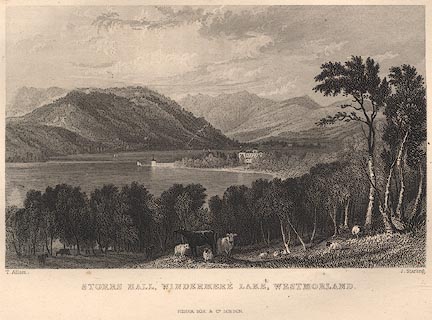 click to enlarge
click to enlargeR240.jpg
item:- JandMN : 66.13
Image © see bottom of page
item:- fishing boat; boat; fishing net
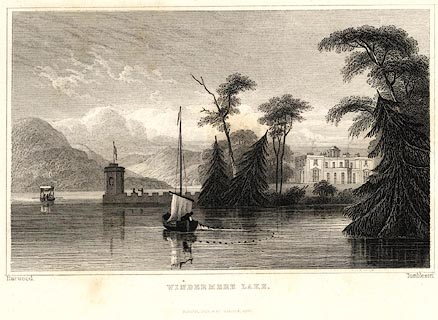 click to enlarge
click to enlargePR0652.jpg
A fisherman in a small sailing boat is using a seine net in the foreground; Storrs in the middle ground.
printed at bottom left, right, centre:- "Harwood. / Tombleson. / WINDERMERE LAKE. / FISHER, SON &Co. LONDON."
item:- Dove Cottage : 2008.107.596
Image © see bottom of page
